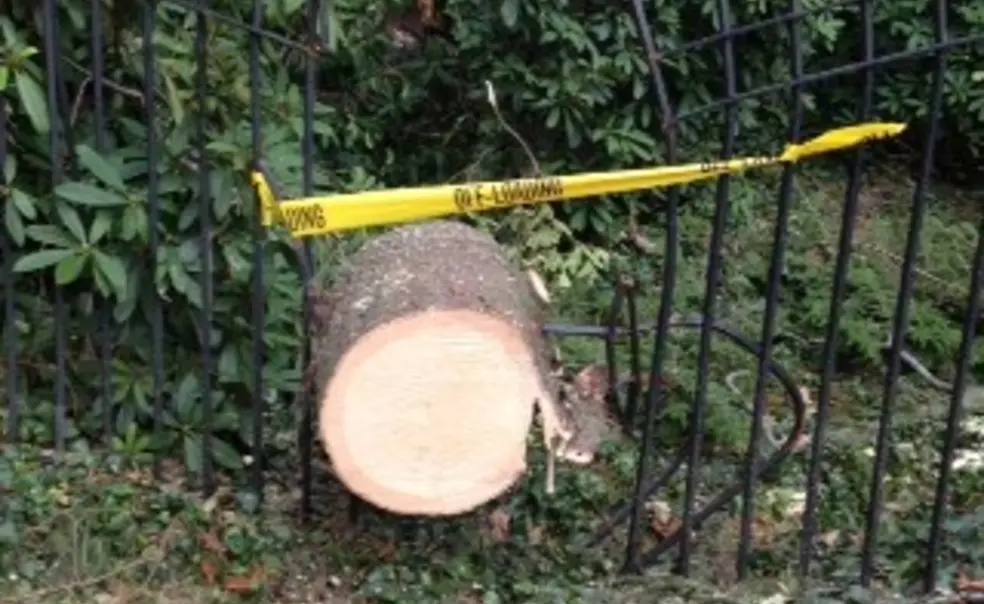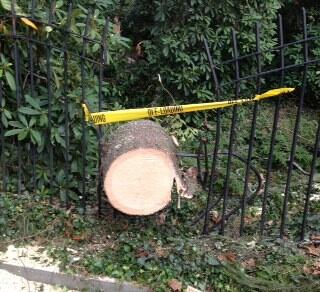Hurricane Sandy update
Monday, 5:29 p.m.: “Trees have come down on campus due to gusty winds,” an emergency text message alert to the University community read. “It’s dangerous outside. Stay indoors.”
One of eight alerts sent out by the Princeton Telephone and E-mail Notification System (PTENS) since Sunday, this message arrived a couple of hours before Hurricane Sandy’s landfall in New Jersey that evening. By the storm’s end, at least 50 trees had come down on the University grounds, including one that destroyed a southern portion of the fence surrounding Prospect Garden.
An estimated 1,200 students were on campus for Sandy, which hit during Fall Break. Many huddled together in dorm rooms, watching movies, cooking, and playing card games to pass the time. “Doing things like building a fort out of blankets or listening to music distracted us from the storm outside,” said Thomas Garcia ’16, who was spending his first break on campus. Earlier in the day on Monday, Rockefeller Dining Hall, the only dining hall open on campus over break, gave students microwavable meals to take home so they wouldn’t have to leave their dorms at night.
The power went out for a few minutes across campus around 7:18 p.m. Monday, but the University switched to generator power from its cogeneration plant and the lights stayed on for the duration of the storm.
For some on campus, anxiety over losing power wasn’t just a fear of the dark. James Corran ’13, development director of WPRB radio station, spent the duration of the storm trying to keep the station on air, which is required by the FCC. Except for the brief power cut, WPRB continued to run throughout the storm, providing its listeners with a mixture of music – including storm-themed songs such as “Stormy Weather” by The Pixies and “Heavy Weather ” by Jarvis Cocker – and emergency alerts.
“Bearing in mind our broadcast range covers all of central Jersey and Philly,” Corran said, “we knew that it was very likely that there were people tuning in who were experiencing power cuts as early as Monday morning, and that we might be their only source of information.” The station kept listeners updated by reading out Web updates between songs.
Throughout the storm, McCosh Health Center continued to be staffed day and night in case of emergency, and the Princeton First Aid and Rescue Squad (PFARS) responded to calls in the township. About a dozen students volunteering with PFARS took part in this effort.
By Tuesday morning, workers began flooding campus to remove fallen trees and mark off unsafe areas on campus. By Friday, most evidence of the storm had been removed, except for a littering of fallen branches and the occasional tilted tree. Regular operations were scheduled to resume Monday, Nov. 5, after offices had been closed for a week for all but essential and critical employees.
As a result of the storm, the Office of Admission has extended its single-choice early action deadline for all applicants to Nov. 7. On Thursday, the Pace Center for Civic Engagement hosted a reception to allow local residents to take advantage of the University’s heating and wireless Internet, and on Friday the Princeton Plasma Physics Laboratory invited community members to use its facilities to shower and charge their electronic devices.
Meredith Wright ’13 said she appreciated the regular safety alerts that students received through text messages, phone calls, and email. “It was nice to see the University caring so much,” she said. “I’m very grateful.”













No responses yet